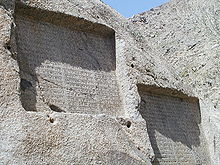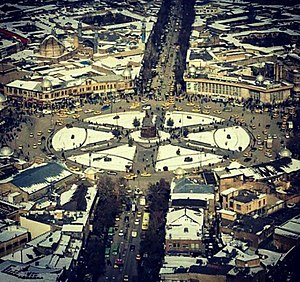Hamadan
| Hamadan | ||
|---|---|---|
| Imam Khomeini Square | ||
|
|
||
| Basic data | ||
| Country: |
|
|
| Province : | Hamadan | |
| Coordinates : | 34 ° 48 ' N , 48 ° 32' E | |
| Height : | 1850 m | |
| Residents : | 676,105 (2016 census) | |
| Area code : | 081 | |
| Time zone : | UTC +3: 30 | |
| Website: | www.hamedan.ir | |
Hamadan (also Hamedan or Hamadaun , Persian همدان, DMG Hamadān ) is a city in western Iran and the capital of the province of the same name .
climate
|
Monthly average temperatures and rainfall for Hamedan (Airport)
|
||||||||||||||||||||||||||||||||||||||||||||||||||||||||||||||||||||||||||||||||||||||||||||||||||||||||||||||||||||||||||||||||||||||||||||||||||||||||||||||||||||||||||||||||||||
location
Hamadan is located in a well watered fruit-growing region on the shores of Qareh the foot of the Zagros -Vorgebirges about 200 kilometers west of Qom (300 kilometers west of Tehran ).
Hamadan is located on the traditional trade route between Baghdad and Tehran or Rey and on the connecting line between Tabriz in the north and Luristan or the Persian Gulf in the south. In the Middle Ages, the entire west of Iran was considered Iraq ʿAdschami and, along with Iraq Arabi, were known as both Iraq . Until 1956 Hamadan belonged to the Iranian province of Kermanshah .
The civil airport Hamadan (English Hamadan Airport ) is located a few kilometers north of the city. The Hamadan military airfield , Hamadan-Shahrokhi , also Noje Airbase , is located around 50 kilometers north of the city.
population
Among the approximately 676,000 mostly Persian inhabitants of the city there are minorities of Azerbaijanis , Kurds , Lurs , a few thousand Armenians and Jews . The Jews speak the Judaeo-Hamadani dialect, the numbers of the Jewish community are declining.
The majority profess Shiite Islam .
history

Hamadan originated in the 2nd millennium BC and was the capital of the Iranian Medes Empire under the name Hagmatana until the 6th century BC. It is thus one of the oldest cities in Iran (perhaps the oldest), from there the three wise men are said to have set out for Bethlehem.
Antiquity: Ekbatana
The name Hamedân or Hamadân is derived from the old Persian Ha (m) gmatâna ( Greek for Ekbatana ). Ha (m) gmatâna probably means 'city of assembly' (from ham-gmata- = come together, cf. Kent, Roland G .: Old Persian - Grammar - Texts - Lexicon, 1953). The nasals "m" and "n" were not written before consonants in the old Persian cuneiform script. Over the centuries, this name was ground to the present-day neo-Persian form.
Middle Ages: flowering under the Bujids and Seljuks
After their victory over the Persian Sassanids in the Battle of Nehawend , the Arab Muslims also conquered Hamadan in 642 , which is also near the site of the Battle of Nehawend. The Arabs made Hamadan the provincial capital; but in 643 and 644 there were initially uprisings against the Arab caliphate .
Arab caliphs
From 804 to 810 the entire region was fought over between the caliph brothers al-Amin and al-Ma'mun . The latter transferred Hamadan to a Barmakid governor. In the middle of the 9th century, a tribe of Hassanid Aliden settled in the city, who provided the respective mayor until 1058 (a branch line even until 1252). Gradually, these Arab descendants of the prophets became Iranian and eventually Shiite . Unlike the rest of Iran - which for the most part only became Shiite in the 17th and 18th centuries - Hamadan became a center of Shiite Islam very early on.
Persian Buyids
In 932 the Bujide al-Hasan Rukn ad-Daula conquered the city on behalf of a Dailamite mercenary leader, immediately went into business and rebuilt Hamadan after the earthquake of 956. When his empire was divided in 976 , Hamadan and Rey became the capital of the Fakr ad-Daula branch, which rivaled the Bujids in Isfahan.
At that time, at the beginning of the 11th century, the great philosopher, scientist and doctor Avicenna was also the prince's vizier in the city. But as early as 1030 , the conquest of Hamadan by Sultan Mahmud of Ghazni ended the Persian dynasty.
Turkish Seljuks
After the defeat of the Ghaznavids against the Seljuks , they established themselves in the city from 1055.
Hamadan reached its peak under the Seljuq sultans, who ruled Baghdad and Rey from here until the middle of the 12th century before they succumbed to the Choresmi. But in 1221 and 1224 the Mongols destroyed the city and killed most of its inhabitants. After the Mongol Ilkhan came the Mongols under Timur , who also had the barely rebuilt city destroyed again in 1386 and 1393; all residents were killed. After the Timurids , the Turkmen Qaraqoyunlu ruled the region from Tabriz from 1405, and finally the Persian Safavids from 1503 .
Modern times: continued wars
After a temporary rule by the Ottoman Turks 1587-1603, the Safavids had Hamadan rebuilt in the 16th century, but in 1724 the Ottoman governor of Baghdad conquered the region again and had Hamadan destroyed again. The Turks were not expelled by Nadir Shah until 1732, followed by the Kurdish Zand from 1751 and the Turkmen Qajars in rule over Hamadan from 1789 . Shah Fath Ali even had Hamadan expanded.
The Constitutional Revolution rose against the Qajars in 1905 , which also affected the conservative Hamadan in 1911 . During the First World War , Hamadan was captured by the Turkish troops in 1915, but was lost to Russian troops in May 1916. From August 1916 to March 1917, the city was briefly in the hands of German and Turkish troops, then the British and in 1918 the Persians again followed.
As part of the Anglo-Soviet invasion of Iran during World War II , British troops occupied Hamadan from September 1941 to 1943. During the First Gulf War , Hamadan was partially destroyed by the Iraqi air force in 1980.
economy
As a trading center on the Silk Road, Hamadan has been famous for grapes, poppy seeds (opium), furs and carpets since ancient times. Today there is industry in Hamadan in addition to agriculture, but the infrastructure seems to be less developed than it is in most other parts of Iran.
The city made more income with the pilgrimage to its sights.
traffic
The city lies on the railway line (Tehran) -Robat Karim-Sanandaj . The single-track line should enable a speed of 160 km / h and will be opened in 2016.
Attractions
Several excavations at Tepe Hagmatana in the center of the city were carried out in the 20th century, whereby Median and especially Achaemenid objects were found, which can be seen today in Tehran's Iranian National Museum. The origin of the stone lion figure ( Sang-e Schir ), a little further south in the center, is unclear. It is partly understood as a Hellenistic sculpture that was commissioned by Alexander the Great for his General Hephaistion, who died in Hamadan . The cuneiform tablets by Ganj Nameh also date from the Achaemenid period , about 12 km from the center at the foot of the Alvand Mountains.
Numerous Jews made a pilgrimage to the supposed grave of the biblical figures Mordechai and Esther , although it is probably “only” the final resting place of a Jewish wife of the Sassanid king Yazdegerd I († 420). The Torah kept there is said to be "only" around three hundred years old.
Also in Hamadan is the tomb of the great oriental scholar Avicenna (Ibn Sina); Avicenna University grew out of his library. A third important tomb is that of Baba Taher , an 11th century Persian poet.
The Mongolian Ilchan Abaqa , who (supposedly) converted to Christianity, also died in Hamadan . Rashīd ad-Dīn , the vizier of his successor, was born in Hamadan and converted to Islam .
Town twinning
-
 Kulob in Tajikistan
Kulob in Tajikistan
-
 Isparta in Turkey
Isparta in Turkey
Famous sons and daughters of the city
- Baba Taher (10th / 11th century), Persian poet
- Raschīd ad-Dīn (1247–1318), Jewish convert to Islam and vizier of the Ilkhan
- Sayyid Ali Hamadhani (1314–1384), Islamic mystic
- Josef Emin (1726–1809), Armenian politician
- Ehsan Yarshater (1920–2018), editor of the Encyclopaedia Iranica
- Abolhassan Banisadr (* 1933), first President of the Islamic Republic of Iran
- Nāser Houshmand Vaziri (* 1946), sculptor
- Shirin Ebadi (* 1947), first Muslim Nobel Peace Prize laureate
Web links
- Hamadan in the Encyclopaedia of the Orient (English)
- Hamadan in the Encyclopaedia Iranica (English)
Individual evidence
- ↑ Statistical Center of Iran: Population by age groups and sex and province, the 2016 Population and Housing Census. (xlsx) Retrieved July 21, 2017 (Excel file, can be downloaded from the website. (Excel; 21 KB)).
- ↑ Hamadan. World Aero Data
- ↑ Hamadan Airport. SkyVector
- ↑ Hamadan Shahrokhi Airport . SkyVector
- ↑ Map ( Memento of the original from August 18, 2014 in the Internet Archive ) Info: The archive link was inserted automatically and has not yet been checked. Please check the original and archive link according to the instructions and then remove this notice. .
- ↑ Report on Islamic Students' News Agency (Persian).








